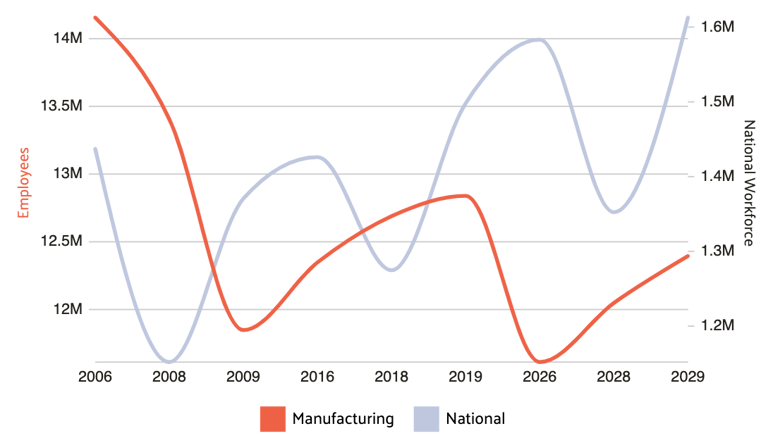How the Labor Crisis Impacts Environmental Compliance in the Manufacturing Industry
The 2019 pandemic brought many lingering effects, including increased employee dissatisfaction and turnover across most industries. The manufacturing industry is particularly affected by the “great resignation” as the increased demand in our consumer economy continues to stretch already underpaid employees even thinner.
Additionally, increasingly stringent environmental regulations continue to hit manufacturers hard, and with our current labor shortage, these businesses are feeling the strain of maintaining both production and compliance. As both the demand for manufactured goods and employee turnover continue to rise, environmental leaders need to be proactive in strengthening their workforce – before it’s too late.
The manufacturing labor shortage
Like many industries across the country, the pandemic was a tipping point for facility workers who were tired of being underpaid and overworked. With a newfound prioritization of work-life balance, many people have been able to change to new careers entirely, leaving manufacturers in a frenzy of trying to fill open positions quickly.When looking at the changes in employment each quarter, the number of job openings and employees quitting each quarter are increasing at a higher rate than the number of jobs being filled. According to the Bureau of Labor Statistics, the manufacturing sector is one of the most rapidly declining industries with an estimated loss of over 139,000 employees by 2030.
The bigger picture
Although the projected number of manufacturing employees should begin increasing again in 2026, this recurring trend over the years shows the overall number steadily decreasing as these positions become more technical and difficult to fill.
Job Growth

In contrast, productivity (in other words, the dollar value of the number of units produced per employee) is only expected to rise in the coming years, likely due to the increasing demand for manufactured products.
Output Growth

How does this impact manufacturing businesses?
So, what happens when the EHS team, which is often seen as a cost sink for a business rather than an integral part of corporate sustainability, doesn’t have the workforce to maintain environmental compliance or the resources to keep up with increased production emissions? As climate change worsens, environmental fines are becoming more severe. Manufacturers can expect more compliance gaps without the workforce needed to stay compliant, resulting in increasingly costly fines and major lawsuits.
How do you prevent employee turnover?
As we’ve seen with increasing employee separation and dissatisfaction rates, overworking employees is not sustainable. Environmental leaders need to make employees feel valued and satisfied in their jobs now to mitigate the risk that comes along with high turnover as the labor shortage continues.In addition to reducing turnover, David from Lehigh Hanson suggests taking a proactive approach to finding quality candidates, rather than just waiting for the right person to apply.
”We do see challenges in attracting employees to environmental roles specifically, but also just to our industry in general. One thing that has worked really well for us – and it’s a long investment – is our internship program. Every summer we bring interns in specifically for environmental roles. We look to expose them to the different aspects of our business. It can yield significant benefits; it gives us candidates that we get to know and we get to test them out, and they get to test us out as well.”
David Perkins, VP of Government Affairs & Communications at Lehigh Hanson
Empowering your employees
Finally, empowering employees with efficient tools and processes will go a long way to ensuring that they find success and fulfillment in their jobs. This will also help environmental leaders prove the ROI of their team, justify costs of compliance, and get leadership across the company involved in a proactive compliance culture that doesn’t just “check the boxes”.



%201%20(2).png)
.png)
.svg)
